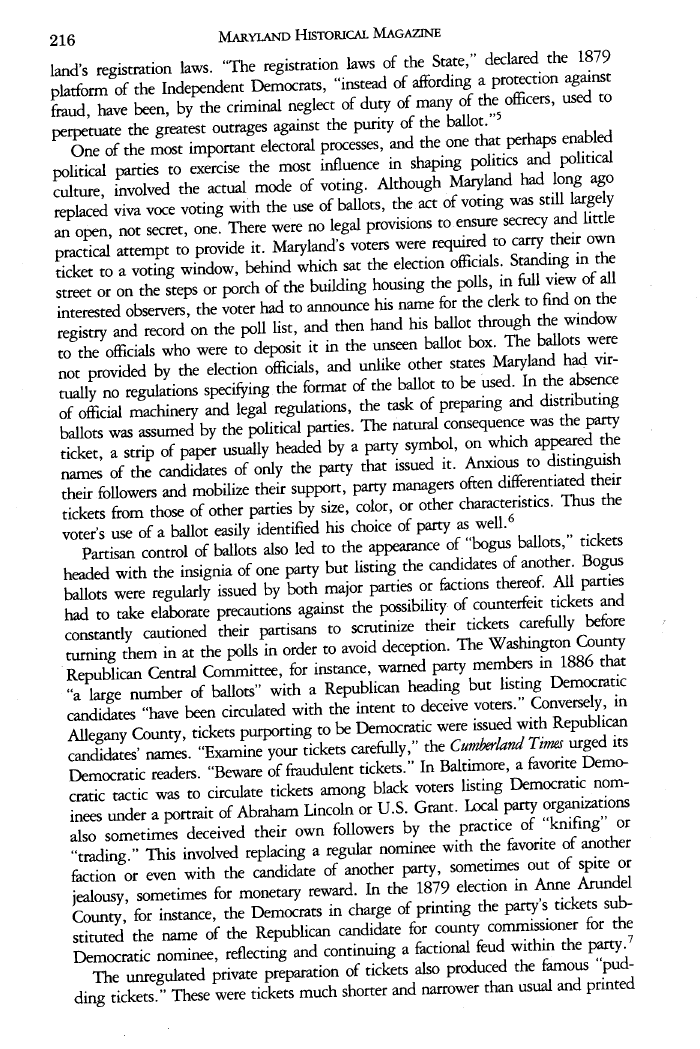|
216
MARYLAND HISTORICAL MAGAZINE
land's registration laws. "The registration laws of the State," declared
the 1879
platform of the Independent Democrats, "instead of affording a protection
against
fraud, have been, by the criminal neglect of duty of many of the officers,
used to
perpetuate the greatest outrages against the purity of the ballot."5
One of the most important electoral processes, and the one that perhaps
enabled
political parties to exercise the most influence in shaping politics and
political
culture, involved the actual mode of voting. Although Maryland had long ago
replaced viva voce voting with the use of ballots, the act of voting was
still largely
an open, not secret, one. There were no legal provisions to ensure secrecy
and little
practical attempt to provide it. Maryland's voters were required to carry
their own
ticket to a voting window, behind which sat the election officials.
Standing in the
street or on the steps or porch of the building housing the polls, in full
view of all
interested observers, the voter had to announce his name for the clerk to
find on the
registry and record on the poll list, and then hand his ballot through the
window
to the officials who were to deposit it in the unseen ballot box. The
ballots were
not provided by the election officials, and unlike other states Maryland
had vir-
tually no regulations specifying the format of the ballot to be used. In
the absence
of official machinery and legal regulations, the task of preparing and
distributing
ballots was assumed by the political parties. The natural consequence was
the party
ticket, a strip of paper usually headed by a party symbol, on which
appeared the
names of the candidates of only the party that issued it. Anxious to
distinguish
their followers and mobilize their support, party managers often
differentiated their
tickets from those of other parties by size, color, or other
characteristics. Thus the
voter's use of a ballot easily identified his choice of party as we11.6
Partisan control of ballots also led to the appearance of "bogus ballots,"
tickets
headed with the insignia of one party but listing the candidates of
another. Bogus
ballots were regularly issued by both major parties or factions thereof.
All parties
had to take elaborate precautions against the possibility of counterfeit
tickets and
constantly cautioned their partisans to scrutinize their tickets carefully
before
turning them in at the polls in order to avoid deception. The Washington
County
Republican Central Committee, for instance, warned party members in 1886
that
"a large number of ballots" with a Republican heading but listing Democratic
candidates "have been circulated with the intent to deceive voters."
Conversely, in
Allegany County, tickets purporting to be Democratic were issued with
Republican
candidates' names. "Examine your tickets carefully," the Cumberland Times
urged its
Democratic readers. "Beware of fraudulent tickets." In Baltimore, a
favorite Demo-
cratic tactic was to
circulate tickets among black voters listing Democratic nom-
inees under a portrait of Abraham Lincoln or U.S. Grant. Local party
organizations
also sometimes ctice of "knifing" or
deceived their own followers by the pra
"trading." This involved replacing a regular nominee
with the favorite of another
faction or even with the candidate of another party, sometimes out of spite
or
jealousy, sometimes for monetary reward. In the 1879 election in Anne
Arundel
County, for instance, the Democrats in charge of printing the party's
tickets sub-
stituted the name of the Republican candidate for county commissioner for
the
Democratic nominee, reflecting and continuing a factional feud within the
party.'
The unregulated private preparation of tickets also produced the famous
"pud-
ding tickets." These were tickets much shorter and narrower than usual and
printed
|

